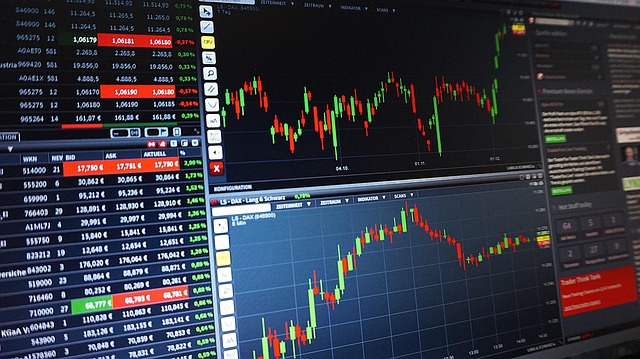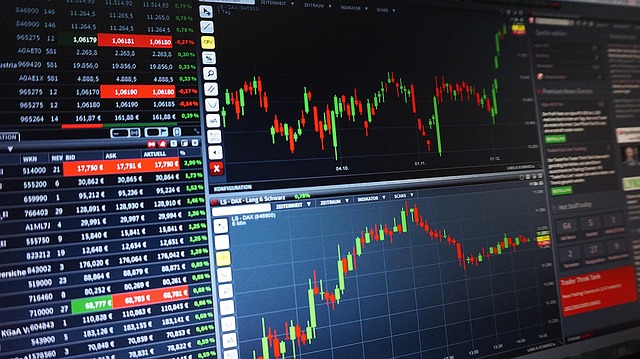Is Trading Futures Harder Than Stocks in 2025? An In-Depth Analysis
Author: Jameson Richman Expert
Published On: 2025-10-02
Prepared by Jameson Richman and our team of experts with over a decade of experience in cryptocurrency and digital asset analysis. Learn more about us.
Trading futures in 2025 continues to be widely regarded as a more complex, volatile, and risk-intensive endeavor compared to traditional stock trading. Historically, the formidable barriers—such as high leverage, rapid market movements, and sophisticated trading mechanics—have kept many investors at bay or limited consistent success. As we progress through 2025—a year marked by breakthrough technological innovations, dynamic regulatory changes, and increasingly interconnected global markets—the critical question arises: Is futures trading genuinely more challenging now than in previous years? Drawing upon extensive practical experience, current market analysis, and emerging technological trends, this article offers a comprehensive deep dive into the nuanced challenges and opportunities of futures versus stocks in 2025. We will explore why futures demand a specialized skill set, psychological resilience, and disciplined strategic execution, while also highlighting how traders can adapt, mitigate risks, and capitalize on opportunities within this highly complex environment.

Fundamental Differences Between Futures and Stocks: An In-Depth Examination
Understanding the core distinctions between futures and stocks is essential to grasp their respective complexities in 2025. Stocks represent ownership shares in a corporation, conferring rights such as dividends and voting power. Stock markets typically operate during predetermined hours—commonly 9:30 AM to 4:00 PM EST—reacting primarily to company fundamentals, economic reports, and macroeconomic sentiment. Price movements tend to be relatively moderate on a per-minute basis, allowing for more predictable day trading and long-term investing strategies.
Conversely, futures are derivative contracts obligating the holder to buy or sell an underlying asset—such as commodities (oil, gold), financial indices, or currencies—at a pre-specified price on a future date. Futures markets are characterized by high leverage, with margin requirements often ranging from 5x to 20x, amplifying both potential gains and losses exponentially. As of 2025, futures markets operate nearly 24/7, reflecting a tapestry of global geopolitical developments, monetary policy shifts, macroeconomic data releases, and technological influences like high-frequency trading (HFT) and AI-driven algorithms. This relentless, continuous trading environment compels traders to monitor markets incessantly, reacting swiftly to breaking news, economic indicators, and sentiment shifts—often within seconds or minutes—making the environment inherently more demanding.
Why Is Futures Trading Considered Significantly More Complex in 2025?
1. Leverage and Margin Management in an Interconnected, Rapid-Paced Environment
Futures leverage magnifies both upside potential and downside risks. In 2025, regulatory frameworks across the globe—such as the U.S. Commodity Futures Trading Commission (CFTC), the European Securities and Markets Authority (ESMA), and others—have imposed stricter margin and leverage caps to enhance retail trader protections. For example, ESMA limits leverage for retail forex and commodity traders to 30:1 or lower, depending on the asset class. Nonetheless, high leverage environments require traders to exercise meticulous risk management. Understanding initial margins, maintenance margins, margin calls, and the importance of maintaining adequate capital buffers is crucial. Miscalculations or neglecting margin requirements during volatile periods can lead to rapid liquidations, often exacerbated by the high-frequency, automated trading systems prevalent in 2025.
2. Navigating Heightened Market Volatility and the Need for Rapid Response
In 2025, geopolitical tensions, persistent inflationary pressures prompting aggressive central bank policies, and technological disruptions such as AI-powered HFT create an environment of heightened volatility. Market swings can occur suddenly and with little warning, often driven by macroeconomic data surprises, political events, or cyber threats. Futures markets, operating near-continuously, demand traders to be vigilant at all hours—monitoring multiple data streams, news feeds, and sentiment indicators. The pressure to execute trades swiftly, adapt strategies dynamically, and maintain composure amidst chaos is immense—testing even seasoned traders’ discipline, emotional control, and capacity to leverage real-time analytics effectively.
3. Mastery of Advanced Analytical Tools and Quantitative Models
Modern futures trading in 2025 relies heavily on sophisticated analytical tools, including machine learning algorithms, sentiment analysis platforms, and big data analytics. Platforms now integrate AI-driven predictive models that analyze vast datasets—ranging from macroeconomic indicators to social media sentiment—allowing traders to identify subtle market signals. Developing proficiency in interpreting complex chart patterns, oscillators, and statistical models is vital. Additionally, mastery over backtesting, customizing algorithms, and deploying AI-based trading systems enables traders to refine entry and exit strategies with high precision. However, dependence on automated systems without understanding their underlying logic can be dangerous—especially during black swan events or macroeconomic shocks that defy models’ predictions. The ability to balance algorithmic insights with human judgment remains a key differentiator in 2025’s trading landscape.
4. Psychological Resilience Amid High-Leverage and Rapid Market Fluctuations
The combination of high leverage, rapid market movements, and emotional stress can induce psychological fatigue. Fear, greed, impatience, and overconfidence often lead to impulsive decisions—potentially catastrophic in a high-stakes environment. Successful futures traders in 2025 cultivate mental toughness through routines such as journaling, mindfulness practices, and adherence to systematic trading plans. They accept losses as inherent to trading, stick to pre-defined risk parameters, and resist the temptation to overtrade or chase fleeting opportunities. Building emotional discipline is paramount to avoid destructive behaviors and to sustain consistent performance over time.
The Evolving Regulatory Landscape and Its Impact in 2025
Regulation remains a critical factor shaping the 2025 futures trading environment. Authorities worldwide aim to enhance transparency and systemic stability through stricter rules—encompassing increased capital requirements, leverage caps, position limits, and comprehensive reporting standards. The U.S. CFTC, for instance, has implemented stricter position limits and margin rules to curb speculative excesses. Reputable trading platforms such as Binance, MEXC, Bitget, and Bybit have adapted by strengthening security protocols, KYC procedures, and compliance frameworks.
For traders, navigating this regulatory landscape means ongoing education and due diligence. Choosing regulated platforms, understanding compliance requirements, and staying updated on regulatory changes are essential for avoiding penalties and capitalizing on emerging opportunities, such as new derivative products or arbitrage strategies. Transparency and adherence to rules foster safer trading environments and contribute to market integrity.

Key Skills and Strategic Approaches for Success in 2025
- Advanced Risk Management: Employ dynamic position sizing, volatility-adjusted stops, and portfolio diversification. Use tools like the Average True Range (ATR) for adaptive stop-loss placement and trailing stops to secure gains while allowing for market fluctuations.
- Technical and Quantitative Mastery: Develop expertise in complex chart analysis, oscillators, and AI-driven predictive models. Use machine learning insights to optimize entry/exit points, improve timing, and adapt to changing market conditions.
- Discipline and Emotional Control: Establish systematic routines—such as pre-trade checklists, meditation, and stress management—to sustain emotional stability. Resisting impulsive decisions during volatile phases distinguishes consistent traders from amateurs.
- Continuous Learning and Community Engagement: Participate in webinars, online communities, and industry events to stay current on technological advances, regulation updates, and innovative strategies. Collaboration fosters adaptability and competitive edge.
- Leveraging Cutting-Edge Technology: Utilize advanced trading platforms featuring algorithmic trading, backtesting environments, and AI analytics. Automation accelerates decision-making, enhances execution accuracy, and allows for rapid strategy evolution.
Personal Lessons from My Futures Trading Journey in 2025
Embarking on futures trading in 2025 has proven to be a rigorous yet rewarding experience. Early missteps—such as underestimating leverage effects, overreacting to volatility, and neglecting thorough risk controls—led to emotional stress and capital drawdown. I discovered that chasing quick gains without a disciplined framework was unsustainable. Over time, adopting a systematic approach—using demo accounts (more on demo accounts in 2025), crafting detailed trading plans, and strictly controlling position sizes—transformed my trading results.
Incorporating AI analytics, sentiment analysis, and real-time news feeds revolutionized my decision-making process. I learned that emotional discipline, ongoing education, and technological proficiency are fundamental to thriving in this environment. Patience, adaptability, and continuous skill development have turned futures trading from an intimidating challenge into a potentially lucrative enterprise—a testament to the importance of discipline and innovation.
Conclusion: Is Trading Futures Still More Difficult Than Stocks in 2025?
In summary, whether futures trading remains more challenging than stocks in 2025 hinges largely on individual skill, experience, risk appetite, and psychological resilience. The complexities introduced by leverage, market volatility, technological dependence, and evolving regulation make futures inherently more demanding. However, these very challenges also open avenues for significant profit for those who are well-prepared, disciplined, and technologically savvy. Success depends on mastering advanced risk management, leveraging innovative tools, and maintaining emotional discipline amidst rapid, unpredictable market dynamics.
For traders eager to deepen their expertise, exploring high-quality resources—such as this detailed analysis of crypto day trading—or guides on AI trading bot development like how to build an AI trading bot in 2025—is highly recommended. Embracing continuous education, disciplined risk management, and technological mastery are the pillars that enable traders to transform futures trading from a formidable challenge into a sustainable, profitable pursuit in 2025 and beyond.